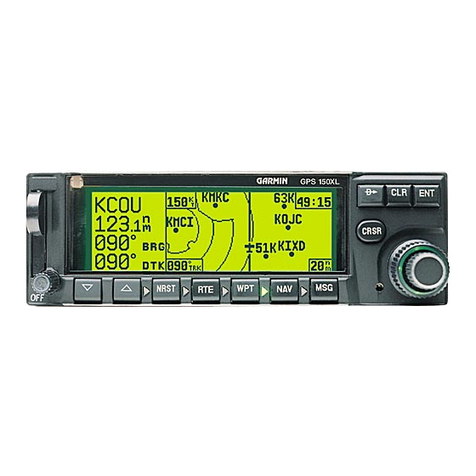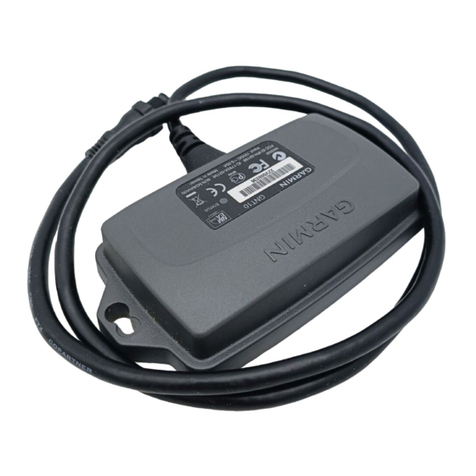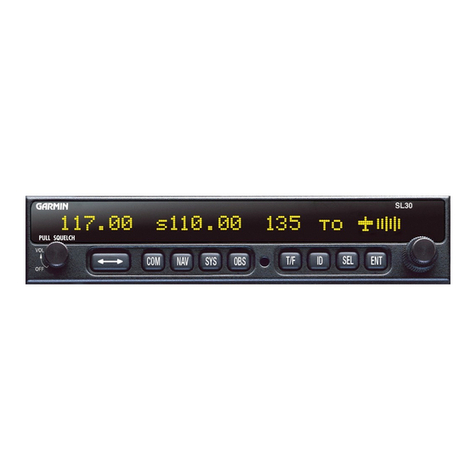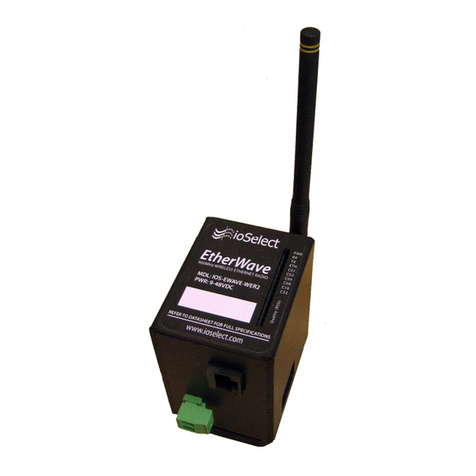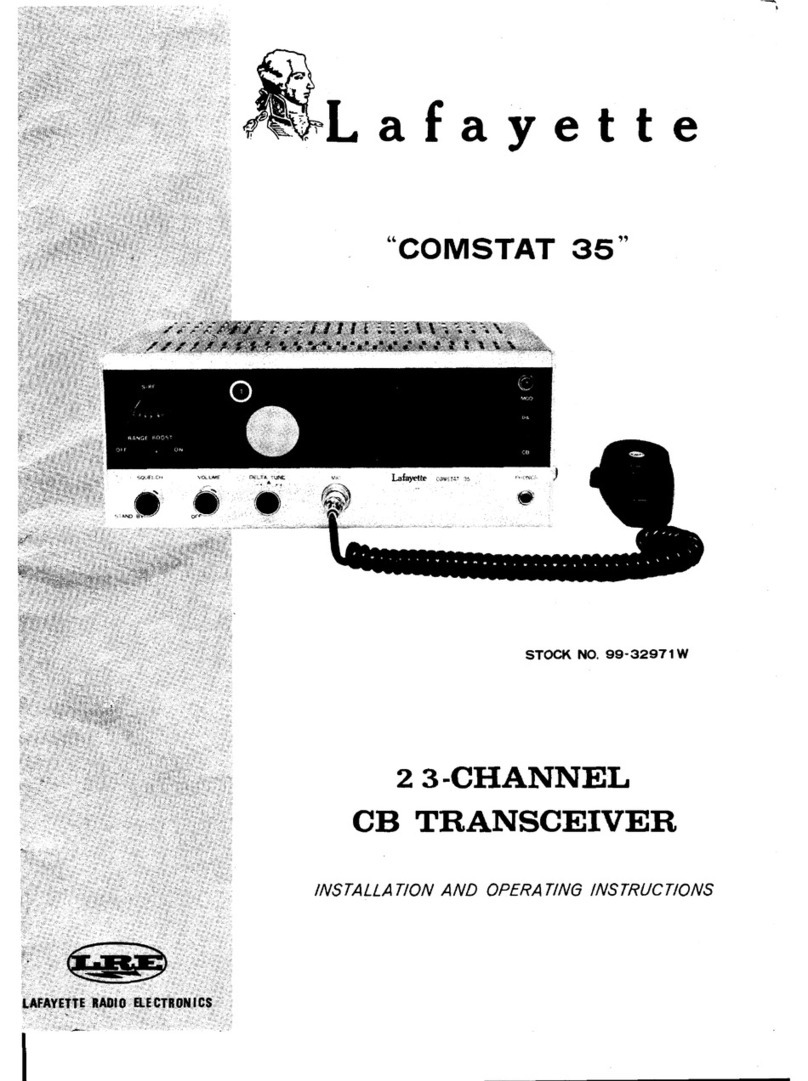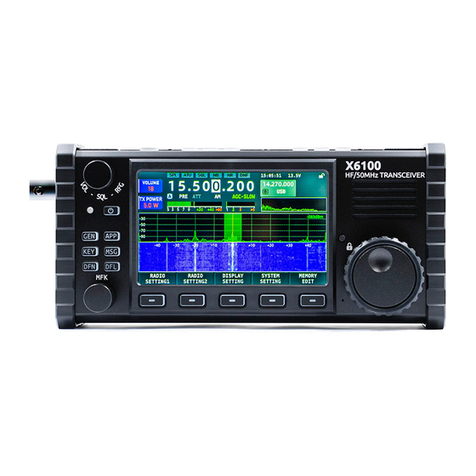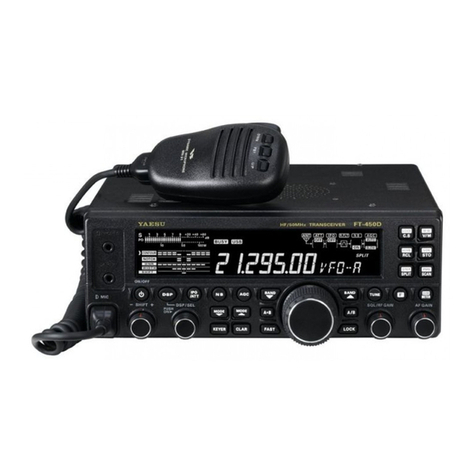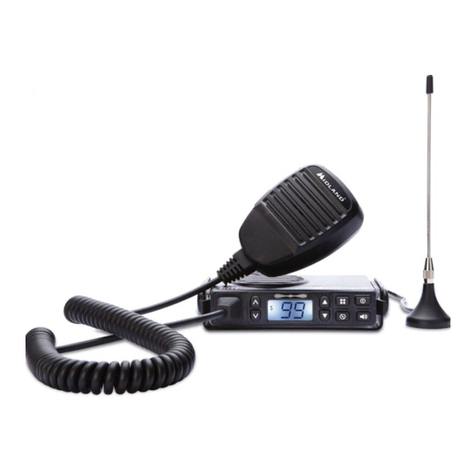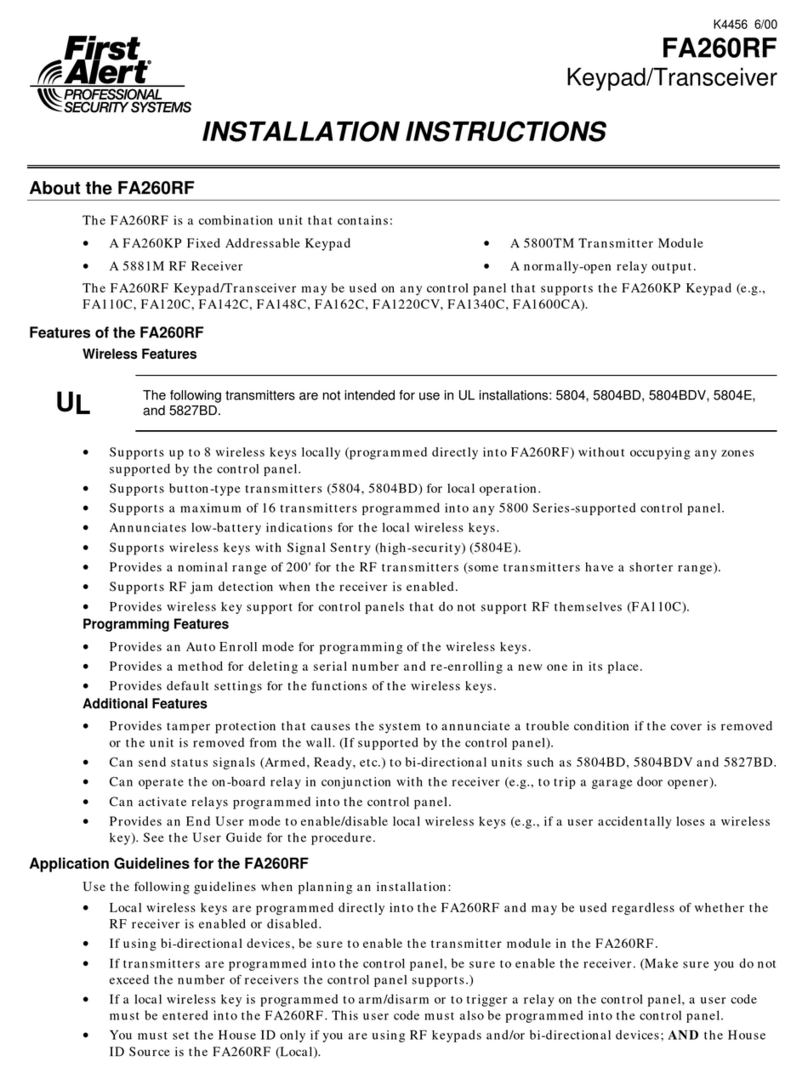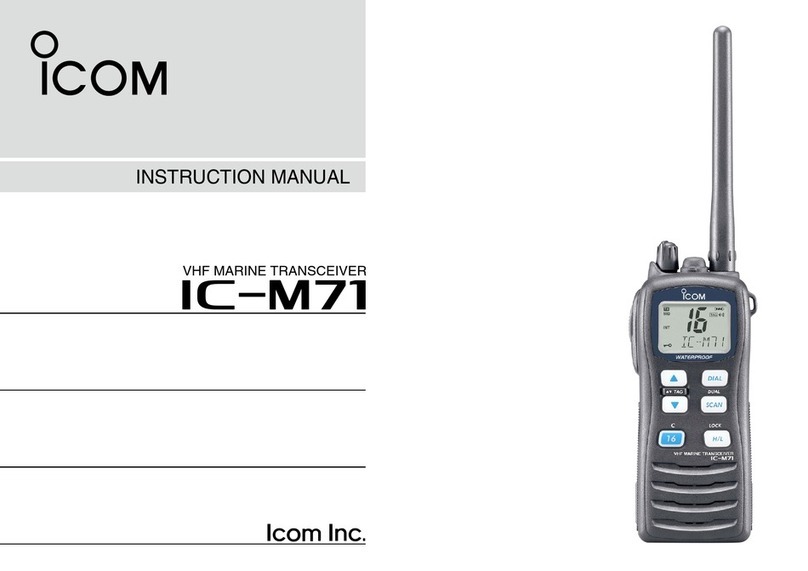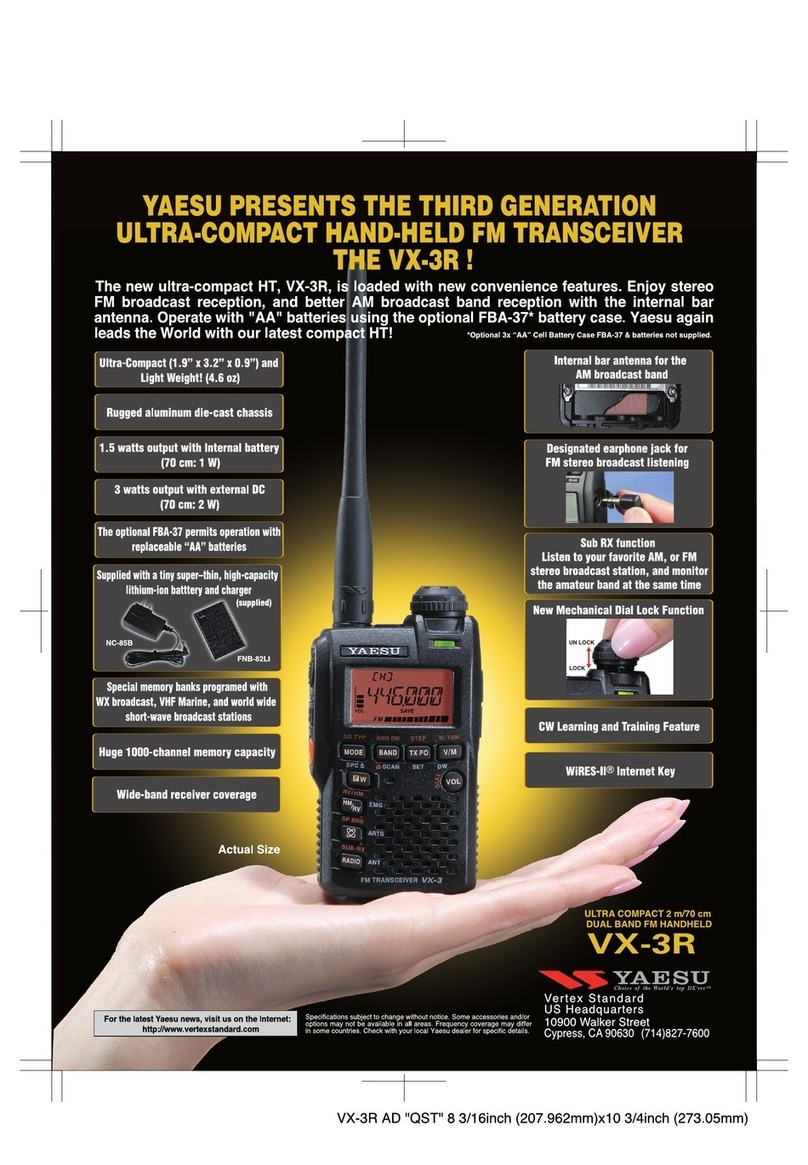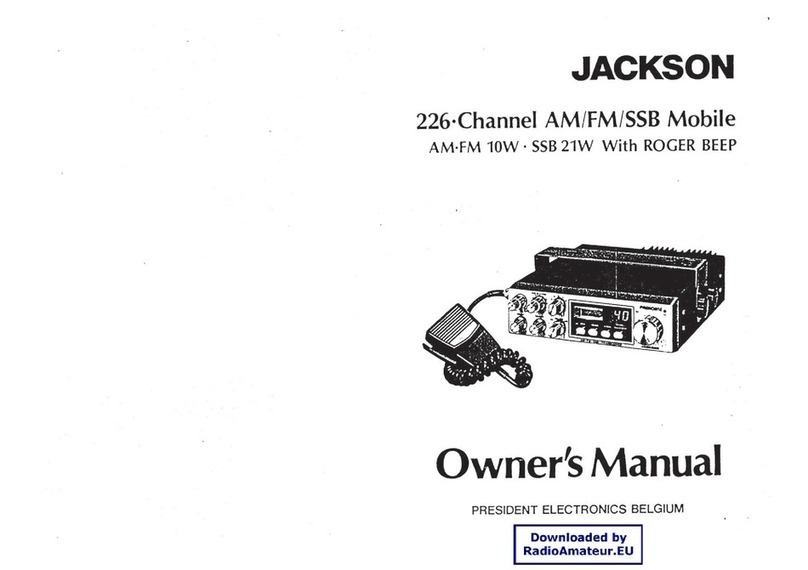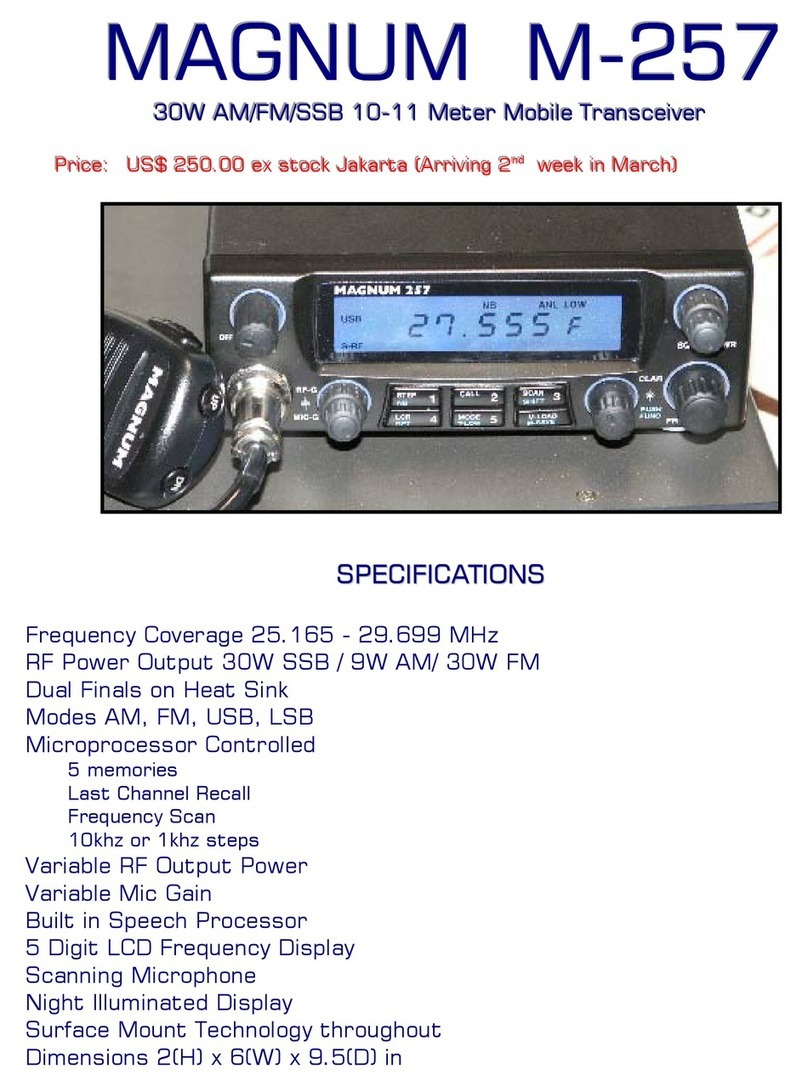Garmin GDL 88 Manual

GDL 88
ADS-B Transceiver
Pilot’s Guide

© 2013 Garmin Ltd. or its subsidiaries. All rights reserved.
This manual reflects the operation of System Software version 2.00, or later. Some differences in operation
may be observed when comparing the information in this manual to later software versions.
Garmin International, Inc., 1200 East 151st Street, Olathe, KS 66062, U.S.A.
Tel: 913/397.8200 Fax: 913/397.8282
Garmin AT, Inc., 2345 Turner Road SE, Salem, OR 97302, U.S.A.
Tel: 503/391.3411 Fax 503/364.2138
Garmin (Europe) Ltd., Liberty House, Bulls Copse Road, Hounsdown Business Park, Southampton, SO40
9LR, U.K.
Tel. +44 (0) 23 8052 4000 Fax +44 (0) 23 8052 4004
Garmin Corporation, No. 68, Zhangshu 2nd Road, Xizhi Dist., New Taipei City 221, Taiwan
Tel: 886/02.2642.9199 Fax: 886/02.2642.9099
Garmin Singapore Pte. Ltd., 46 East Coast Road, #05-06 Eastgate, Singapore 428766
Tel : (65) 63480378 Fax : ( 65 ) 63480278
At Garmin, we value your opinion.
Please send questions or comments about this manual or other Garmin publications to Techpubs.Salem@
garmin.com.
Techpubs[email protected]
www.garmin.com
https://fly.garmin.com/fly-garmin
Except as expressly provided herein, no part of this manual may be reproduced, copied, transmitted,
disseminated, downloaded or stored in any storage medium, for any purpose without the express written
permission of Garmin. Garmin hereby grants permission to download a single copy of this manual and of
any revision to this manual onto a hard drive or other electronic storage medium to be viewed for personal
use, provided that such electronic or printed copy of this manual or revision must contain the complete text
of this copyright notice and provided further that any unauthorized commercial distribution of this manual or
any revision hereto is strictly prohibited.
This part shall comply with Garmin Banned and Restricted Substances document, 001-00211-00.
Garmin®is a registered trademarks of Garmin Ltd. or its subsidiaries. These trademarks may not be used
without the express permission of Garmin.
June 2013 Printed in the United States

i
190-01122-03 Rev. C
Garmin GDL 88 ADS-B Transceiver Pilot’s Guide
WARNING: For safety reasons, GDL 88 operational procedures must be
learned on the ground.
WARNING: This unit provides the ability to receive weather information
through external sources. Use weather data only as an aid to situational
awareness. Such weather information is merely supplemental and advisory
in nature and is not intended to be relied upon as safety-critical information
in connection with any aviation, vehicle, or marine usage. The user should
always exercise caution and common sense when confronted with severe
weather conditions.
WARNING: Do not use data link weather information for maneuvering in,
near, or around areas of hazardous weather. Information contained within data
link weather products may not accurately depict current weather conditions.
WARNING: Traffic information is provided as an aid in visually acquiring
traffic. Pilots must maneuver the aircraft based only upon ATC guidance or
positive visual acquisition of conflicting traffic.
CAUTION: The Garmin GDL 88 does not contain any user-serviceable
parts. Repairs should only be made by an authorized Garmin service center.
Unauthorized repairs or modifications could void both the warranty and the
pilot’s authority to operate this device under FAA/FCC regulations.
NOTE: All visual depictions contained within this document, including images
of the GDL 88 and the bezel, displays, and screens of other products are
subject to change and may not reflect the most current software or hardware.
Depictions of equipment may differ slightly from the actual equipment.
NOTE: This device complies with part 15 of the FCC Rules. Operation is
subject to the following two conditions: (1) this device may not cause harmful
interference, and (2) this device must accept any interference received,
including interference that may cause undesired operation.
NOTE: This product, its packaging, and its components contain chemicals
known to the State of California to cause cancer, birth defects, or reproductive
harm.This notice is being provided in accordance with California’s Proposition
65. If you have any questions or would like additional information, please
refer to our web site at www.garmin.com/prop65.

ii
Garmin GDL 88 ADS-B Transceiver Pilot’s Guide
190-01122-03 Rev. C
NOTE: This device complies with Part 15 of the FCC limits for Class B digital
devices. This equipment generates, uses, and can radiate radio frequency
energy and, if not installed and used in accordance with the instructions,
may cause harmful interference to radio communications. Furthermore, there
is no guarantee that interference will not occur in a particular installation.
If this equipment does cause harmful interference, the user is encouraged
to try to correct the interference by relocating the equipment or connecting
the equipment to a different circuit than the affected equipment.
Consult an authorized dealer or other qualified avionics technician
for additional help if these remedies do not correct the problem.
Operation of this device is subject to the following conditions: (1) This
device may not cause harmful interference, and (2) this device must accept
any interference received, including interference that may cause undesired
operation.

iii
190-01122-03 Rev. C
Garmin GDL 88 ADS-B Transceiver Pilot’s Guide
Record of Revisions
Part Number Revision Date Description
190-01122-03 A
B
C
10/19/12
04/12/13
06/19/13
Initial release
Prepared document for print production.
Revised NEXRAD description.

iv
Garmin GDL 88 ADS-B Transceiver Pilot’s Guide
190-01122-03 Rev. C
To obtain accessories for your unit, please contact your Garmin dealer.
Help us better support you by completing our on-line registration form today!
Registration ensures that you will be notified of product updates and new
products and provides lost or stolen unit tracking. Please, have the serial
number of your unit handy, connect to our web site (www.garmin.com or
https://fly.garmin.com/fly-garmin) and look for our Product Registration link
on the Home page.

v
190-01122-03 Rev. C
Garmin GDL 88 ADS-B Transceiver Pilot’s Guide
Contents
1 Introduction .........................................................................................1-1
1.1 GDL 88(D) System Functions ................................................................1-1
1.2 GDL 88 Part Numbers ..........................................................................1-2
2 ADS-B System Overview ......................................................................2-1
2.1 ADS-B - Broadcast (ADS-B) .................................................................. 2-3
2.2 Automatic Dependent Surveillance – Rebroadcast (ADS-R) ...................2-4
2.3 Traffic Information Service - Broadcast (TIS-B).......................................2-5
2.4 Flight Information Service – Broadcast (FIS-B).......................................2-6
3 GDL 88 ADS-B Out................................................................................3-1
3.1 GDL 88 ADS-B Out Data ...................................................................... 3-1
3.2 Self-Interrogation................................................................................. 3-2
3.3 Pressure Altitude Broadcast Inhibit (PABI).............................................3-2
3.4 Anonymous Mode................................................................................3-3
3.5 Air/Ground Determination.................................................................... 3-3
4 GDL 88 ADS-B IN..................................................................................4-1
4.1 GDL 88 ADS-B In Data ......................................................................... 4-1
4.2 Traffic ..................................................................................................4-2
4.2.1 Traffic Applications – SURF, AIRB, etc......................................4-2
4.2.2 GDL 88 Integration with TCAD/TAS/TCAS I.............................4-5
4.2.3 No-Heading Source Traffic Information...................................4-6
4.2.4 Conflict Situational Awareness (CSA) ..................................... 4-6
5 Weather ...............................................................................................5-1
5.1 FIS-B NEXRAD .....................................................................................5-2
5.1.1 NEXRAD Abnormalities.......................................................... 5-3
5.1.2 NEXRAD Limitations..............................................................5-3
5.1.3 NEXRAD Intensity.................................................................. 5-4
5.1.4 NEXRAD ...............................................................................5-4
5.2 FIS-B TFRs .............................................................................5-6
5.3 FIS-B METARs........................................................................5-6
5.4 FIS-B PIREPs.......................................................................... 5-7
5.5 FIS-B Winds and Temperatures Aloft....................................... 5-7
5.6 SIGMETs and AIRMETs .......................................................... 5-7

vi
Garmin GDL 88 ADS-B Transceiver Pilot’s Guide
190-01122-03 Rev. C
6 Installation configurations...................................................................6-1
6.1 Possible Installation Configurations ...................................................... 6-1
6.1.1 GDL 88 with ADS-B Out Transmission Enabled........................6-1
6.1.2 GDL 88 with ADS-B Out Transmission Disabled....................... 6-1
6.1.3 GDL 88 Only – No Display .....................................................6-1
6.2 Interfaces ............................................................................................6-2
6.2.1 Audio Panel...........................................................................6-2
6.2.2 Altitude Source...................................................................... 6-2
6.2.3 Heading Source (optional) .....................................................6-2
6.2.4 GPS Position Source ..............................................................6-2
6.2.5 Radar Altimeter (Optional) ..................................................... 6-2
6.2.6 Traffic Mute (Optional)........................................................... 6-2
7 Glossary ...............................................................................................7-1
8 Appendix..............................................................................................8-1
8.1 Troubleshooting...................................................................................8-1
8.2 Servicing Your Unit............................................................................... 8-2
8.3 Contact Garmin ................................................................................... 8-2
8.4 Software License Agreement ................................................................ 8-3
8.5 LIMITED WARRANTY............................................................................ 8-4
Index.....................................................................................................Index-1

1-1
190-01122-03 Rev. C
Garmin GDL 88 ADS-B Transceiver Pilot’s Guide
1 INTRODUCTION
The GDL 88 is a remotely mounted ADS-B transceiver. There are four models
of the GDL 88(D). Models with a single bottom mounted UAT antenna meet TSO
C154c Class A1S and are available with or without an internal GPS/SBAS receiver.
Models with one top mounted and one bottom mounted antenna meet TSO C154c
Class A1H and are also available with or without an internal GPS/SBAS receiver.
1.1 GDL 88(D) System Functions
The GDL 88 performs the following functions:
• UAT transmission (978 MHz)
The GDL 88 transmits ADS-B Out data on the 978 MHz (UAT) frequency
to be received by other aircraft, vehicles, and ATC for situational
awareness and traffic management.
• UAT reception (ADS-B, ADS-R, TIS-B, and FIS-B) on 978 MHz
The GDL 88 receives ADS-B data transmitted on the UAT link from
other aircraft, vehicles, and ground stations to present a traffic situational
awareness display for use by the flight crew. In addition, the GDL 88
receives FIS-B data on the UAT link to provide the flight crew with
graphical and textual weather products.
• Mode-S Extended Squitter reception on 1090 MHz
The GDL 88 receives ADS-B data transmitted by aircraft on the 1090 MHz
link to provided a comprehensive situational awareness traffic display for
use by the flight crew.
• Correlation of traffic reports from multiple traffic sources, including no
heading source installations
The GDL 88 is capable of interfacing with TCAD/TAS/TCAS I systems
to create and present a “fused” situational awareness display to the flight
crew.
• Output of ADS-B and TAS/TCAS I traffic data to an external display
The GDL 88 is capable of providing a situational awareness traffic display
on compatible displays.
• Output of FIS-B weather data to an external display
The GDL 88 is capable of providing various textual and graphical weather

1-2
Garmin GDL 88 ADS-B Transceiver Pilot’s Guide
190-01122-03 Rev. C
products for display on compatible displays.
• Traffic alerting
The GDL 88 provides aural and visual cues of impending traffic conflicts,
to include directional aural (“Traffic, Traffic, Two O’clock, Two Miles,
Low”).
• Single point of entry for transponder squawk code, IDENT, and
emergency status
1.2 GDL 88 Part Numbers
Part Number Description
010-00859-30 GDL 88
010-00860-30 GDL 88, Internal WAAS with install kit
010-00861-30 GDL 88 Diversity with install kit
010-00862-30 GDL 88 Diversity, Internal WAAS with install kit
Table 1-1 GDL 88 Configurations

2-1
190-01122-03 Rev. C
Garmin GDL 88 ADS-B Transceiver Pilot’s Guide
2 ADS-B SYSTEM OVERVIEW
ADS-B is a core technology in the FAA Next Gen air traffic control system and
is comprised of three segments: ADS-B (Broadcast), ADS-R (Rebroadcast), and
TIS-B.
Nearly 400 ADS-B ground stations were completed and operational by mid-
2012, with most of the rest — totaling more than 700 planned stations —
expected to be operational by early 2014. The graphic below illustrates where
ADS-B is currently operational. In the areas highlighted in blue, you can already
start taking advantage of ADS-B’s datalink traffic and subscription-free weather
services if you’re equipped with an ADS-B “In” solution.
Figure 2-1 ADS-B Ground Stations (mid-2012) - FAA Illustration

2-2
Garmin GDL 88 ADS-B Transceiver Pilot’s Guide
190-01122-03 Rev. C
Figure 2-2 ADS-B Coverage vs Altitude (Planned for 2014) - FAA Illustration

2-3
190-01122-03 Rev. C
Garmin GDL 88 ADS-B Transceiver Pilot’s Guide
2.1 ADS-B - Broadcast (ADS-B)
ADS-B is the automatic broadcast of position reports by aircraft, surface
vehicles, and transmitters on fixed objects. These broadcasts contain much more
data than just a simple position report, they include: identity (Flight ID, Call
Sign, Tail Number, ICAO registration number, etc), ground track, ground speed,
pressure altitude, indications of multitude capabilities, and emergency status. This
list of data is non-inclusive of other data fields and bits used for various other
functions.
Figure 2-3 ADS-B Operation - FAA Illustration
Garmin display units have the capability to show the status of the ground station
services being received. Examples for the GTN and GNS products are shown below.
See the display device Pilot Guide for the symbology used on that display.
Unit Symbol Description
GNS Within coverage of a TIS-B ground station when connected
to a GDL 88.
GNS Not within coverage of a TIS-B ground station when
connected to a GDL 88.
GNS GDL 88 does not have a valid track or heading and cannot
place ADS targets on the display.
GTN Within coverage of a TIS-B ground station when connected
to a GDL 88.
GTN Not within coverage of a TIS-B ground station when
connected to a GDL 88
Table 2-1 Map TIS-B Availability Symbols

2-4
Garmin GDL 88 ADS-B Transceiver Pilot’s Guide
190-01122-03 Rev. C
2.2 Automatic Dependent Surveillance –
Rebroadcast (ADS-R)
Because it is not required that ADS-B In capable aircraft be able to receive
ADS-B data on both the 1090 MHz and 978 MHz data links, a means to get data
from one data link to the other is required. ADS-R is the rebroadcast of ADS-B data
by FAA ground stations and provides this service by taking data from one link and
rebroadcasting it on the other. For example, two aircraft are in the service volume
for a ground station, and one transmitting on 1090 MHz and the other 978 MHz,
the ground station will retransmit the data from each aircraft on the other link to
ensure the two aircraft can “hear” each other.
Figure 2-4 ADS-R Operation - FAA Illustration
The GDL 88(D) is capable of receiving ADS-B traffic reports directly on a 1090
MHz data link in addition to traffic reports and FIS-B weather uplinks on the
978 MHz data link. This allows the GDL 88 to directly receive all ADS-B position
reports from aircraft in the vicinity guaranteeing the most complete traffic picture
is available to the flight crew without relying on being within ground station
coverage and ADS-R to provide this complete picture.

2-5
190-01122-03 Rev. C
Garmin GDL 88 ADS-B Transceiver Pilot’s Guide
2.3 Traffic Information Service - Broadcast (TIS-B)
TIS-B provides the bridge between the current, radar based, ATC system and
the future ADS-B based system. When an ADS-B In or Out capable aircraft is
within the service volume of an FAA ADS-B ground station, the ground station
will begin to broadcast a portion of the ATC radar picture to the aircraft. This
aircraft is then included in the list of aircraft that is being provided TIS-B service
and is then considered a “TIS-B participant.”
TIS-B coverage can be made available when the aircraft is within ground station
coverage, in Secondary Surveillance Radar coverage, and the other aircraft has to
be in secondary surveillance radar coverage and transmitting altitude.
ATC radar tracks for other aircraft within ±3,500 feet and 15 NM of the
participant will be provided by the ground station, to include altitude, position,
ground speed, and ground track. TIS-B data is broadcast once every three to
thirteen seconds depending on the characteristics of the radar providing the data
to the ground station.
Figure 2-5 TIS-B Operation - FAA Illustration
NOTE: Even if the display is showingTIS-B traffic, unless theTIS-B participant
indication is present (see Section 2.1) ,TIS-B services are not being provided
specific to your aircraft and the traffic picture may not be complete.

2-6
Garmin GDL 88 ADS-B Transceiver Pilot’s Guide
190-01122-03 Rev. C
2.4 Flight Information Service – Broadcast (FIS-B)
FIS-B is provided on the 978 MHz link only and is broadcast from the FAA
ground stations continuously. This service provides multiple weather products
for display in the cockpit to be used by the flight crew for situational awareness.
These products, update rates, and coverages are specified in the Aeronautical
Information Manual section 7-1-11(d)(7). Examples of these products include
NEXRAD Precipitation, Graphical TFRs, Graphical AIRMETs/SIGMETs, METARs,
TAFs, winds aloft, status of Special Use Airspaces (SUA), and textual NOTAMs.
Figure 2-6 FIS-B Operation - FAA Illustration

3-1
190-01122-03 Rev. C
Garmin GDL 88 ADS-B Transceiver Pilot’s Guide
3 GDL 88 ADS-B OUT
ADS-B Out sends information from the aircraft so it can be “seen” by other
aircraft using ADS-B In equipment and FAA ground stations. ADS–B Out provides
air traffic controllers with real-time position information that is, in most cases,
more accurate than the information available with current radar-based systems.
With more accurate information, ATC will be able to position and separate aircraft
with improved precision and timing.
3.1 GDL 88 ADS-B Out Data
ADS-B Out data is transmitted on the UAT (978 MHz).
• GPS position
• Altitude
• Position Integrity
• Ground Track and/or Heading
• Ground Speed
• Velocity Integrity
• Air/Ground State
• Identifying information (Transponder Squawk Code, Call sign, ICAO
Registration Number, Flight ID), integrity, and capability data.
Figure 3-1 GDL 88 ADS-B In and Out

3-2
Garmin GDL 88 ADS-B Transceiver Pilot’s Guide
190-01122-03 Rev. C
The following table describes the aircraft that will be observed by a GDL 88
equipped aircraft according to the level of equipment installed in the other aircraft.
Other Aircraft Equipage Viewable by GDL 88
Equipped Aircraft
1090ES Out Equipped Yes
UAT Receive Only Capable No
UAT Transmit Equipped Yes
No Transponder, No ADS-B No
Non ADS-B Equipped, but with Mode C or S Transponder Yes (see Note)
Table 3-1 Aircraft Available for Viewing by an ADS-B Equipped Ownship
NOTE: Only when in ADS-B ground station coverage and when the other
aircraft is in ATC radar coverage.
3.2 Self-Interrogation
For installations with a digital interface between the GDL 88 and the installed
transponder, the transponder acts as a single control to enter the transponder
squawk code, IDENT, and emergency status.
When a digital interface is not available, the GDL 88 is configured to utilize
self-interrogation. The GDL 88 has a small, ultra low power 1030 MHz transmitter
integrated into the unit that interrogates the transponder installed in the aircraft.
This interrogation looks exactly like the interrogations received from ground
based surface search radars and the transponder replies like it is designed to do,
to include the squawk code, IDENT status, and emergency status. The GDL 88
receives this reply and sets the corresponding ADS-B Out message values to match
the received data.
3.3 Pressure Altitude Broadcast Inhibit (PABI)
Much like with Mode C transponders, a method is required to be available to
the flight crew to inhibit the transmission of pressure altitude in the ADS-B Out
message. This could be used for certain surface operations, in the event of a failure
of an altitude source in the ownship, etc. This control may either be integrated
into the controlling display or as a stand-alone switch installed in the cockpit.
While conducting operations within airspace requiring ADS-B Out compliant
Out transmissions, per 14 CFR 91225, PABI should not be activated unless
directed by ATC.

3-3
190-01122-03 Rev. C
Garmin GDL 88 ADS-B Transceiver Pilot’s Guide
3.4 Anonymous Mode
The GDL 88 provides an Anonymous Mode which broadcasts a randomized
ICAO address in the ADS-B Out message. The Anonymous Mode, when armed,
will replace the Flight ID with a temporary randomized number for privacy while
the position information will still be provided. This randomized address allows
the ADS-B Out message to not be tied to a specific aircraft, much like a VFR
squawk code of 1200 on a Mode A or Mode C transponder. The mode is armed
via a switch in the cockpit or via a control on the display integrated with the GDL
88. When a VFR squawk is present in the transponder and anonymous mode
is selected, then the GDL 88 operates in anonymous mode and no identifying
information is provided in the ADS-B Out message. This mode will persist until
the squawk code is changed or the Anonymous Mode control is turned to the off
state.
Anonymous Mode is not available when installed in an aircraft with a Mode S
transponder.
3.5 Air/Ground Determination
If a weight on wheels or squat switch is installed, the GDL 88 will use that
input to determine air/ground status. If not, then air/ground status is purely based
on GPS-derived information.

3-4
Garmin GDL 88 ADS-B Transceiver Pilot’s Guide
190-01122-03 Rev. C
This page intentionally left blank
Other manuals for GDL 88
1
Table of contents
Other Garmin Transceiver manuals
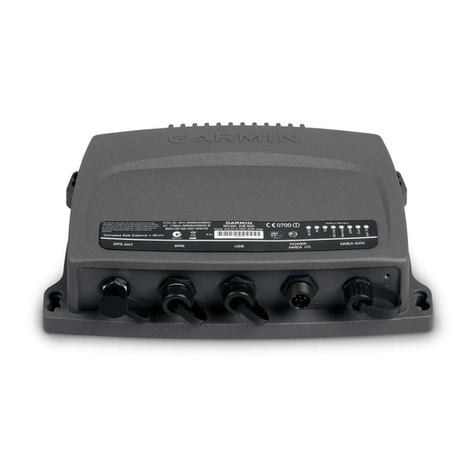
Garmin
Garmin AIS 600 Reference guide

Garmin
Garmin GTR 200 User manual
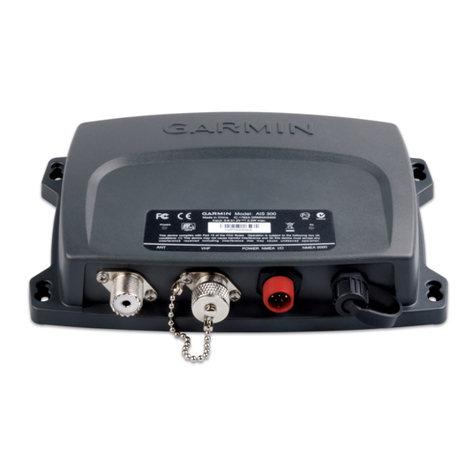
Garmin
Garmin AIS 300 Reference guide
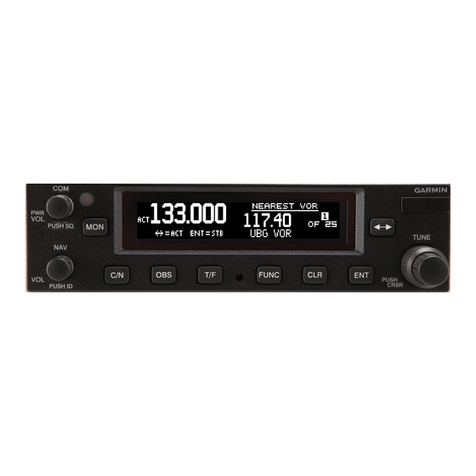
Garmin
Garmin GTR 225 User manual
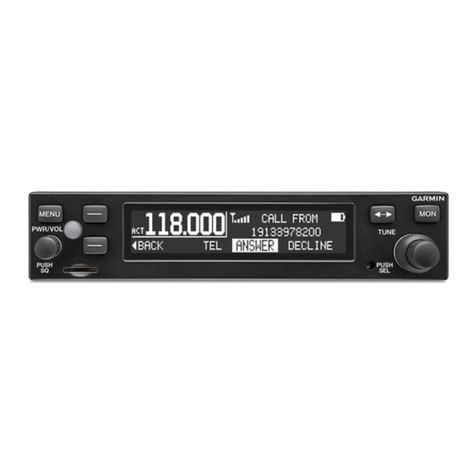
Garmin
Garmin GTR 200 User manual

Garmin
Garmin GTR 200 Manual
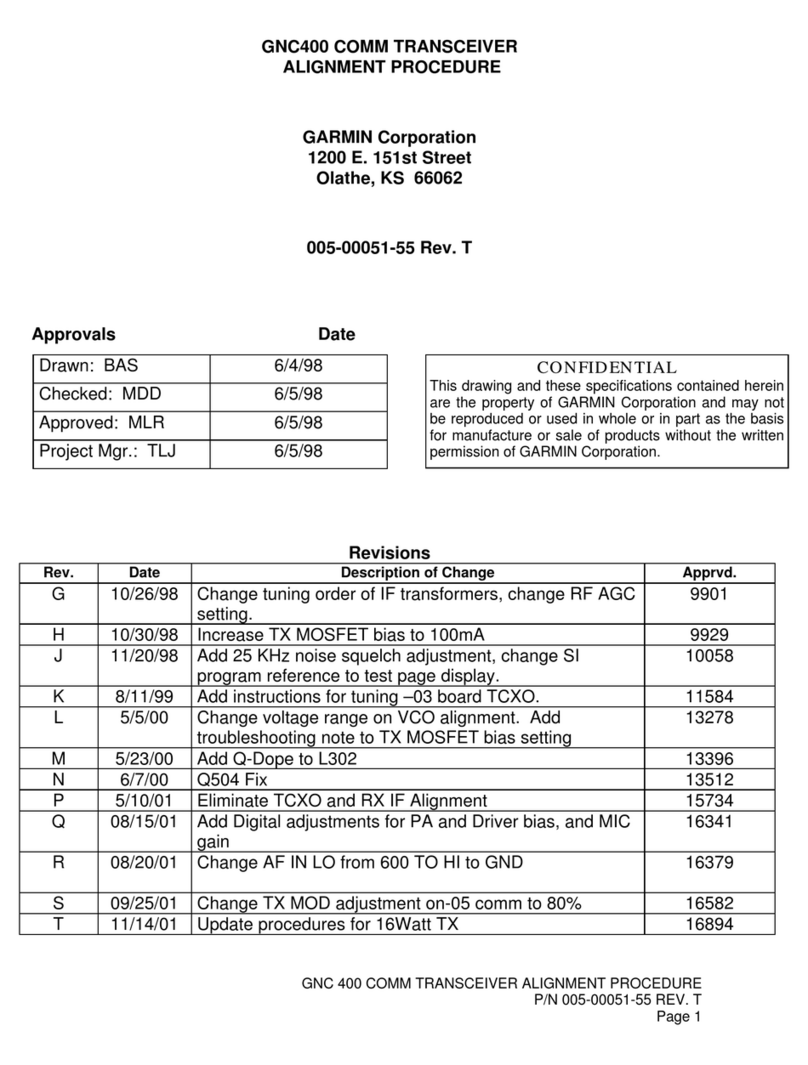
Garmin
Garmin GNC400 Manual
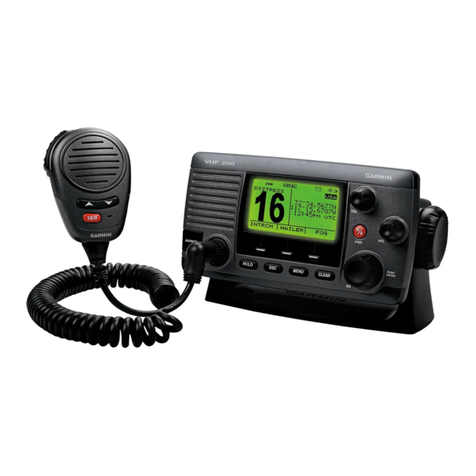
Garmin
Garmin VHF 200 Series User manual

Garmin
Garmin GTR 225 Manual
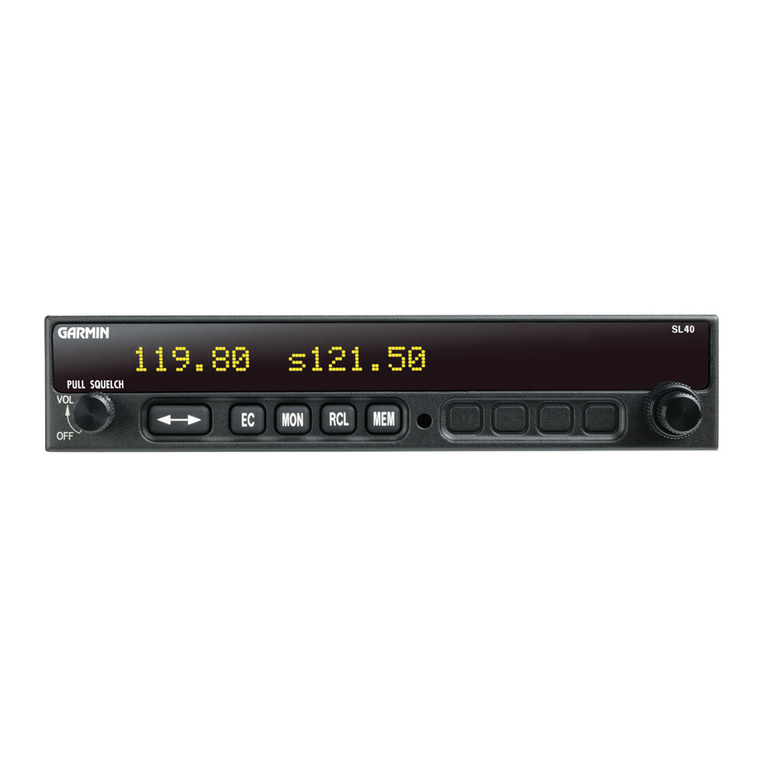
Garmin
Garmin Apollo SL40 User manual
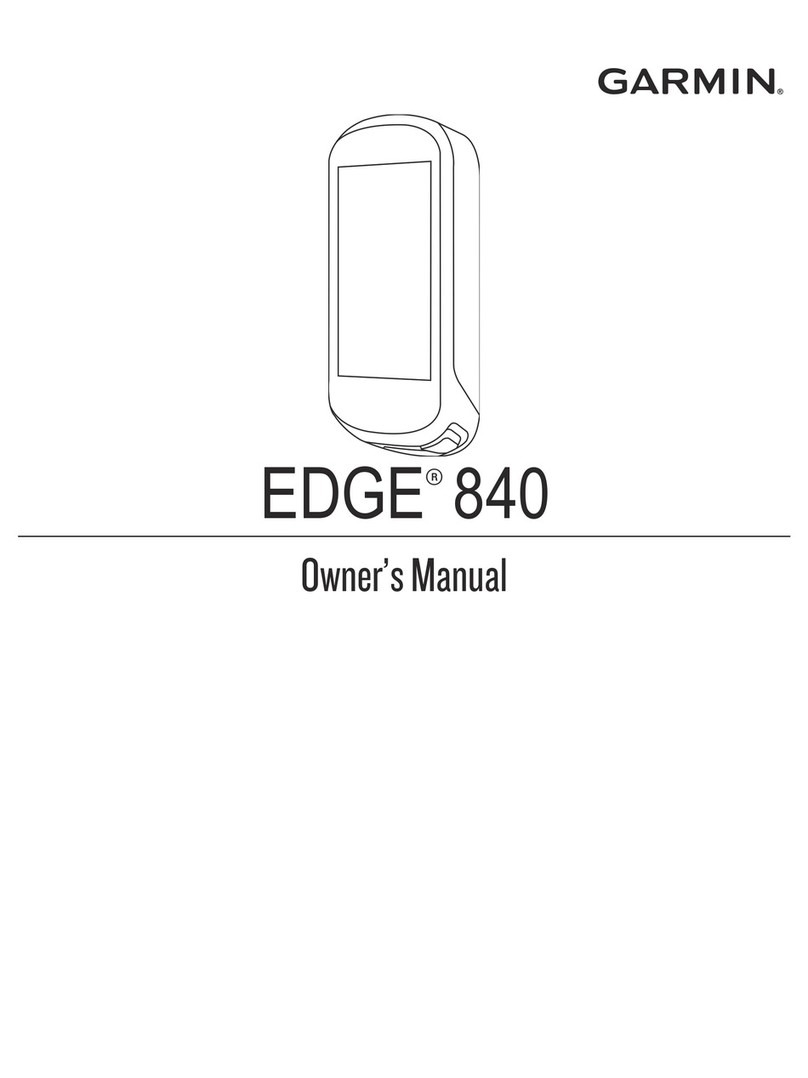
Garmin
Garmin EDGE 840 User manual

Garmin
Garmin GDL 88H Technical specifications

Garmin
Garmin GDR 66 User manual
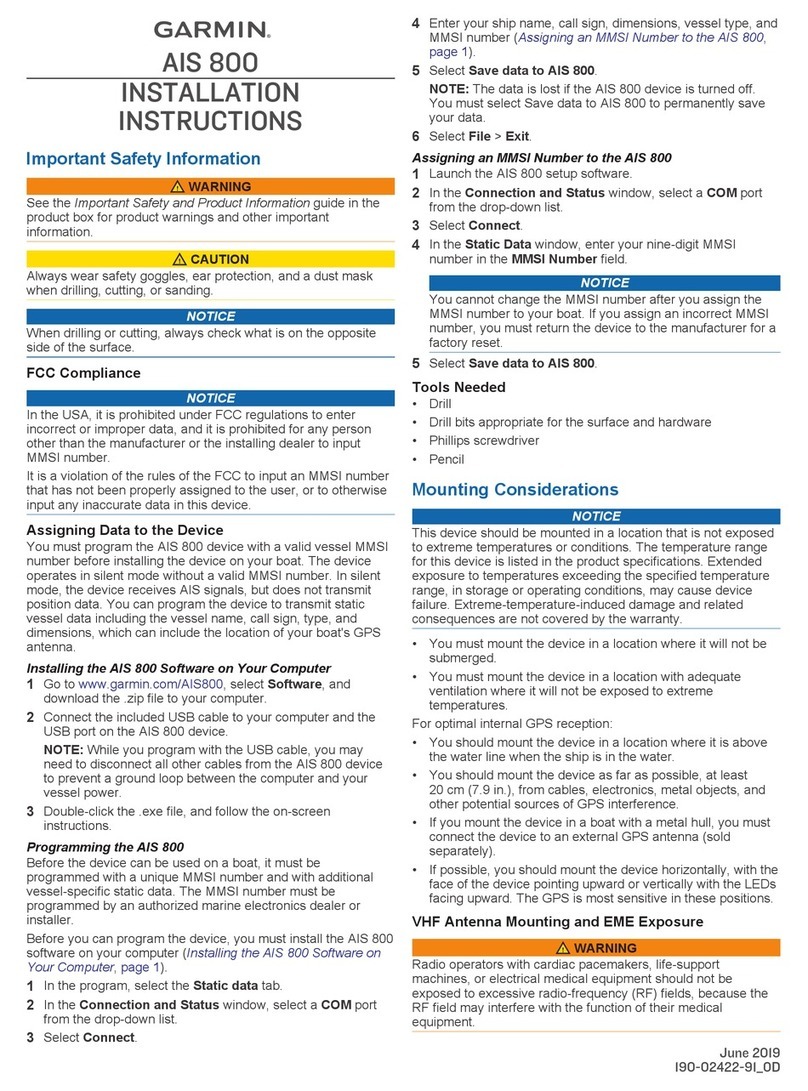
Garmin
Garmin AIS 800 User manual
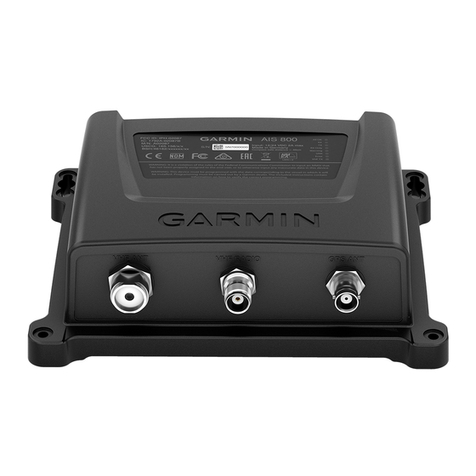
Garmin
Garmin AIS 800 User manual

Garmin
Garmin AIS 800 User manual
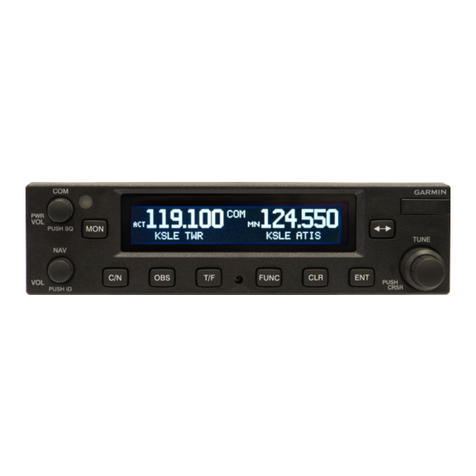
Garmin
Garmin GNC 255A Manual
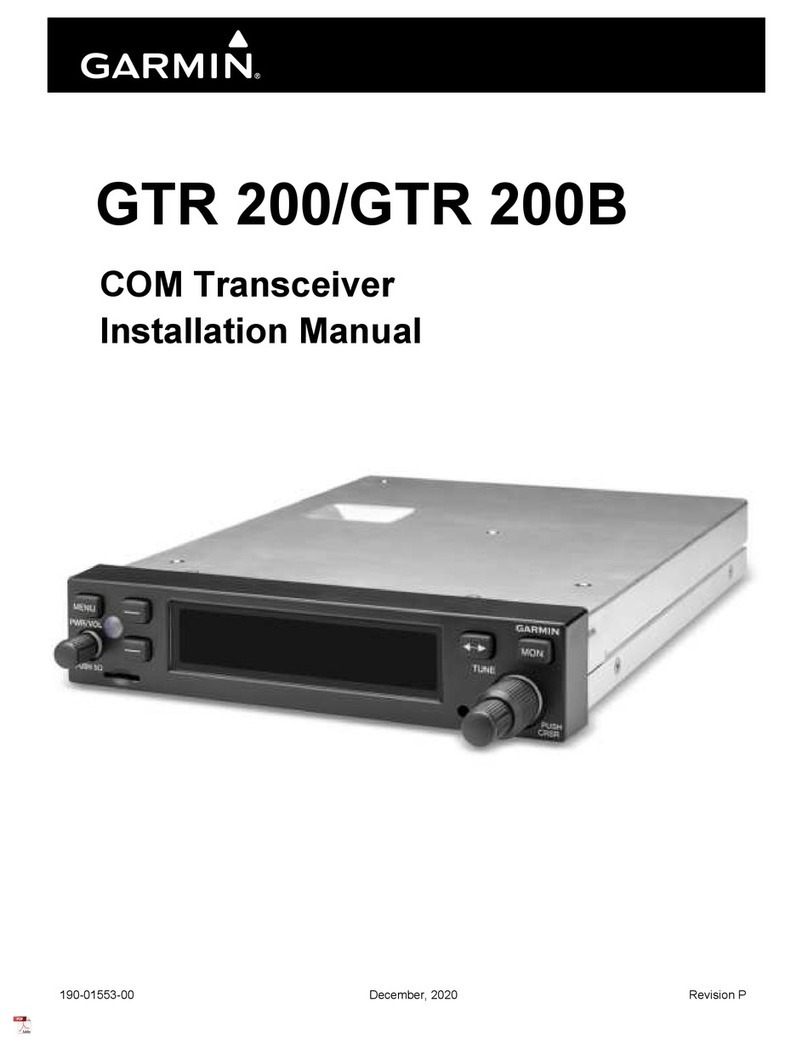
Garmin
Garmin GTR 200B User manual
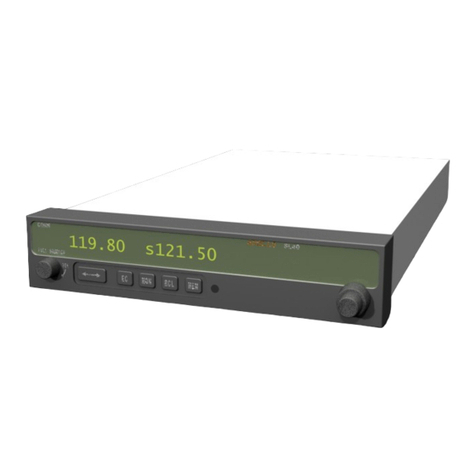
Garmin
Garmin echomap 40 series Manual
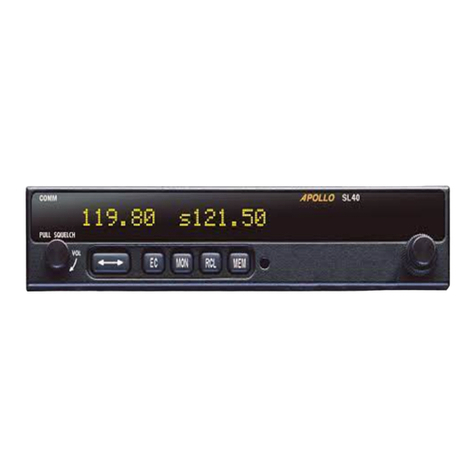
Garmin
Garmin Apollo SL40 User manual
